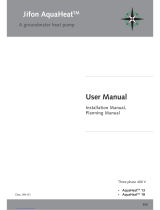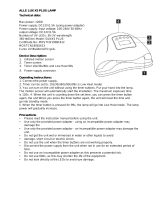
Contents
1 About documents and decals ...................................................... 3
1.1
Introduction .................................................................................... 3
1.2 Symbols in documents ................................................................ 3
1.3 Symbols on decals ........................................................................ 3
1.4 Terminology .................................................................................... 5
2 Important information .................................................................... 6
2.1 General safety precautions ........................................................ 6
2.2 Refrigerant ....................................................................................... 6
2.3 Electrical connection .................................................................... 7
2.4 Water quality ................................................................................... 7
2.5 Commissioning .............................................................................. 8
3 Transport, unpacking and positioning ...................................... 9
3.1 Transporting heat pump ............................................................ 9
3.2 Unpacking heat pump ................................................................ 9
3.3 Positioning the heat pump ........................................................ 9
4 The heat pump ................................................................................ 13
4.1 Dimensions and connections ................................................. 13
4.2 Components ................................................................................. 15
4.3 Principle description .................................................................. 17
4.4 Heating ........................................................................................... 17
4.5 Hot water function ..................................................................... 18
4.6 Defrost function .......................................................................... 19
4.7 Cooling function ......................................................................... 20
4.8 Check and safety functions ..................................................... 21
5 System solution ............................................................................... 24
5.1 System solution DHP-AQ Mini ............................................... 24
5.2 System solution DHP-AQ Midi ............................................... 24
5.3 System solution DHP-AQ Maxi ............................................... 25
5.4 System solution intermediate exchanger .......................... 27
6 Piping installation .......................................................................... 29
6.1 Pipe connection .......................................................................... 29
6.2 Connecting cold and hot water lines .................................. 29
6.3 Connecting the heating system supply and
return lines ..................................................................................................... 29
6.4 Noise and vibrations .................................................................. 30
7 Electrical Installation ..................................................................... 32
7.1 Control centre .............................................................................. 32
7.2 Electrical cabinet in heat pump ............................................. 33
7.3 Cable connection ........................................................................ 33
7.4 Position and connect outdoor sensors ............................... 34
7.5 Connecting supply and return pipe sensors ..................... 34
7.6 Connect hot water sensor to external heater ................... 35
7.7 Connecting circulation pump ................................................ 35
7.8 Connect heating cable driptray ............................................. 35
7.9 Connect the communication cable ...................................... 35
7.10 Connecting the power supply ............................................. 36
8 Operator panel ................................................................................ 37
8.1 Manage operator panel ............................................................ 37
8.2 Operating modes ........................................................................ 38
8.3 Symbols .......................................................................................... 38
8.4 Operational information .......................................................... 39
8.5 Important parameters ............................................................... 39
9 Information menu .......................................................................... 47
9.1 Menu overview ............................................................................ 47
9.2 OPERAT. .......................................................................................... 47
9.3 HEATING ......................................................................................... 47
9.4 DISTRIBUTION CIRCUIT 1 - 2 .................................................... 48
9.5 HOT WATER ................................................................................... 49
9.6 COOLING ........................................................................................ 49
9.7 POOL ................................................................................................ 50
9.8 BUFFER TANK ............................................................................... 50
9.9 OP. DATA ........................................................................................ 51
9.10 OPERAT. TIME ............................................................................ 51
9.11 DEFROST ...................................................................................... 52
9.12 CALENDAR .................................................................................. 52
9.13 ALARM .......................................................................................... 53
9.14 LANGUAGE ................................................................................. 53
10 Service menu ................................................................................. 54
10.1 Menu overview ......................................................................... 54
10.2 HOT WATER ................................................................................ 54
10.3 HEATING ...................................................................................... 55
10.4 COOLING ..................................................................................... 56
10.5 AUX. HEATER .............................................................................. 56
10.6 MANUAL TEST ............................................................................ 57
10.7 INSTALLATION ........................................................................... 58
10.8 DEFROST ...................................................................................... 60
10.9 OPTIMUM .................................................................................... 61
10.10 BUFFER TANK .......................................................................... 62
11 Commissioning ............................................................................. 65
11.1 Filling and bleeding the hot water heater
and heating system ..................................................................................... 65
11.2 Checking the pipes and electrical installation ............... 65
11.3 Configuration of control system ......................................... 66
11.4 Manual test ................................................................................. 67
11.5 Start-up and commissioning ................................................ 69
11.6 Installation protocol ................................................................ 70
11.7 Customer information ............................................................ 70
12 Technical data ............................................................................... 71
12.1 Working range compressor operation ............................. 73
VMGFD102 – 1
























